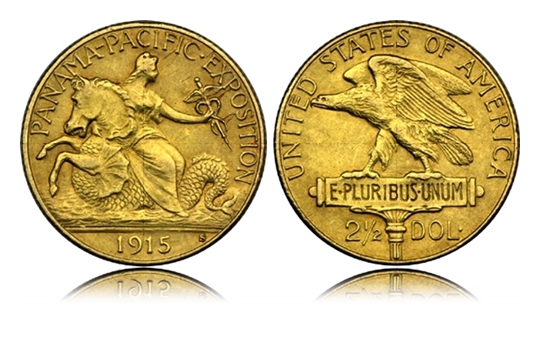
The 1915 S Pan-Pacific Quarter Eagle
On January 21, 1915 four artists were awarded the right to design one of the coins for the Pan-Pacific International Exposition.
The quarter eagle was given to Mrs. Evelyn B Longman. Mrs. Longman had her sketches for the coin returned to the Mint Director by January 27th and he forwarded them to Treasury Secretary William McAdoo. McAdoo worked quickly, rejecting the designs on the 29th. This rejection was not transmitted to Longman until February 5th. Mrs. Longman returned to work and had four new designs prepared by February 19th. These designs were subsequently rejected as well.
Since the mint was short on time, the coins were supposed to be ready at the opening of the exposition on February 20th, they turned to Chief Engraver Charles Barber for a design. On March 8th they notified Barber that they needed him to design the quarter eagle. Knowing that the Mint might need designs at the last moment, Barber had been working on a design for the fifty dollar coin. Now he simply changed the denomination and within just a few days and the Treasury adopted the design on March 19th.
The obverse of Barber’s design shows a female figure seated on a hippocampus holding a caduceus. Above the central figure is PANAMA PACIFIC EXPOSITION and the date is placed at the bottom. The S mintmark is to the right at about 4:30. The female figure is Columbia not Liberty. Columbia is used to symbolize both North and South America. The hippocampus or seahorse represents transportation by water, both of people or cargo. This is a reference to the Panama Canal. The caduceus represents Medicine and relates to the conquering of yellow fever and malaria that was rampant in the Canal Zone and which had been one of the things that had defeated many other attempts at the digging of a canal over the previous one hundred years.
The reverse shows a defiant eagle copied from a design by George Morgan standing on a standard with E PLURIBUS UNUM on it. UNITED STATES OF AMERICA is above the eagle and the denomination is at the bottom divided by the pole of the standard. Walter Breen suggests that the defiant eagle may have been a symbol of the need to keep the canal open with the world war now underway in Europe.
The dies for the quarter eagles were created in Philadelphia and three pairs of dies were shipped to San Francisco on May 27th. All of the quarter eagles were struck in the three day period of June 22nd through June 24. Ten thousand and eleven coins were struck and they were offered for sale at the Exposition at a price of $4.00 each. Sales were not exactly brisk but of course since the coins had gone on sale so late they missed most of the early visitors. When the exposition ended on December 4th the unsold coins were returned to the Mint. On October 27th, 1916 3,266 quarter eagles were consigned to the melting pot leaving a total mintage of 6,745 coins.
There are no significant varieties known for this coin and with the small mintage it is quite possible they are all from a single pair of dies. There may have been some die trials struck without a mintmarks as was done with the dollar and half dollar coins but no dies without a mintmark were shipped to San Francisco. (The first shipments of dollar and half dollar dies had no mintmark. The people in Philadelphia felt that since all the coins would be struck in San Francisco there was no need for a mintmark but local civic pride felt otherwise. They wanted no confusion in the future as to where the coins came from.)